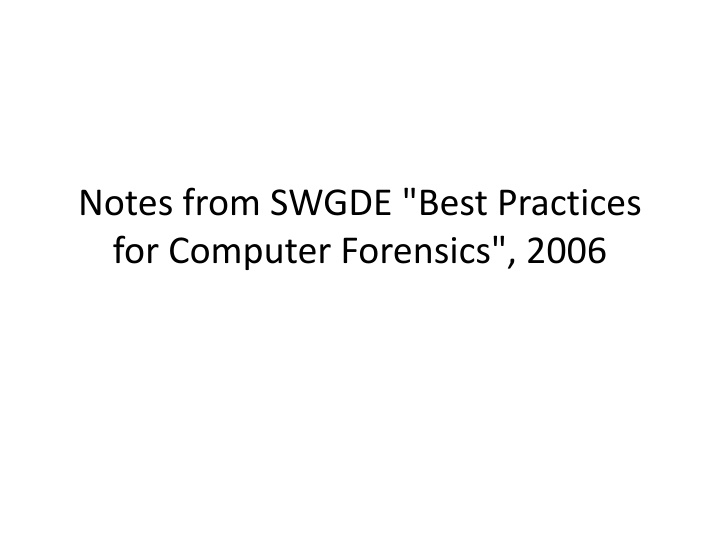
Computer Forensics Best Practices and Guidelines
Explore the best practices for computer forensics based on SWGDE's guidelines from 2006. Topics include seizing evidence, evidence handling, and specific procedures for different types of computer systems like stand-alone and networked computers.
Download Presentation

Please find below an Image/Link to download the presentation.
The content on the website is provided AS IS for your information and personal use only. It may not be sold, licensed, or shared on other websites without obtaining consent from the author. If you encounter any issues during the download, it is possible that the publisher has removed the file from their server.
You are allowed to download the files provided on this website for personal or commercial use, subject to the condition that they are used lawfully. All files are the property of their respective owners.
The content on the website is provided AS IS for your information and personal use only. It may not be sold, licensed, or shared on other websites without obtaining consent from the author.
E N D
Presentation Transcript
Notes from SWGDE "Best Practices for Computer Forensics", 2006
1.0 Seizing Evidence Must have legal authority Additional authority for additional evidence outside scope of the search If evidence cannot be removed, image it at the scene Remove all suspects, witnesses, and bystanders from the scene
1.0 Seizing Evidence Solicit information from potential suspects, witnesses, LAN administrators, etc. Passwords, operating systems, screen name, email address Search scene systematically and thoroughly Searcher should be able to recognize the different types of evidence
1.1 Evidence Handling If the computer is off, leave it off If the computer is on, consider the potential of encryption If appropriate, image the machine before powering down Assess the power need for devices with volatile memory E.g. cell phones, tablets, etc.
1.1 Evidence Handling Document the condition of the evidence Photograph whole scene from several angles Close-up photographs of cables, serial numbers, etc. Document connection of external components Document any pre-existing damage to the evidence
1.1.1 Stand-alone Computer (Non-Networked) Disconnect all power sources Remove battery from laptops Place evidence tape over power plug connector on the back of the computer
1.1.2 Networked Computer Workstations Remove the power connector from the back of the computer Place evidence tape over the power plug connector on the back of the computer
1.2 Servers Determine the extent of data to be seized Capture volatile data if necessary If shutdown is necessary, use the appropriate commands Warning: Pulling the plug could severely damage the system; disrupt legitimate business; and/or create officer and department liability.
Evidence Handling Package evidence to protect it from change Maintain chain-of-custody Packaging: Plastic/paper bags or sleeves Computer case sealed with evidence tape over access points and power connectors Devices with volatile memory should be packaged appropriately to allow for power to be maintained to the device
Evidence Handling Care with transportation, to avoid Physical damage Vibration Magnetic fields Static electricity Large variations in temperature or humidity
2.0 Equipment Preparation "Equipment" is non-evidentiary hardware and software used for imaging or analysis Equipment must be monitored and documented to maintain proper performance Test equipment regularly
3.0 Forensic Imaging Document the current condition of the evidence Prevent exposure to toxic or dangerous substances on the evidence Use write blockers Use forensically sound and verifiable acquisition methods Hashes: MD5, SHA-1, etc.
3.0 Forensic Imaging Capture "bit-stream" forensic image Use properly prepared media when making forensic copies Ensure no commingling of data from different cases Forensic image should be archived to media
4.0 Forensic Analysis/Examination Review documents from requestor to determine necessary processes Need legal authority, such as: Consent by owner Search warrant Other legal authority
4.0 Forensic Analysis/Examination Preliminary considerations Urgency and priority of request Additional types of examination which may need to be carried out (e.g. fingerprints) Other evidence items that may need to be requested, such as removable USB drives Examine copies, not original evidence Logical and systematic examination
Recommended Civil Case Search Procedure Look at USBSTOR first to see what other devices to request Examine documents, photos, Internet history, email, desktop
Recommended Search Procedure Start with keywords from description of case Name of suspect, company involved, etc. Search for evidence by keyword Find more keywords in that evidence Search using new keywords When you aren't finding any new keywords, the search is done
4.1 Non-Traditional Technologies Cell phones, PDA's, iPods, DVR's, gaming systems, etc. Gather forensic images if possible Non-traditional methods may be required Validate procedures first if possible Document all steps in methodology
5.0 Documentation Evidence handling documentation Copy of legal authority Chain of custody Initial count of evidence items Information re: packaging and condition of evidence upon receipt by the examiner Description of evidence Communications regarding the case
5.0 Documentation Examination documentation Case-specific Contain sufficient details to allow another competent forensic examiner to identify what has been done and assess the findings independently Preserve documents
6.0 Reports Reports should address the requestor's needs Provide all information in a clear and concise manner
